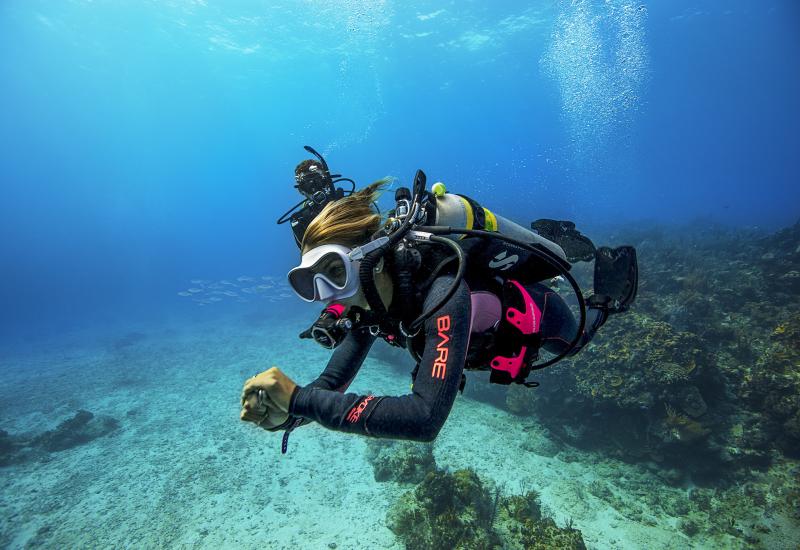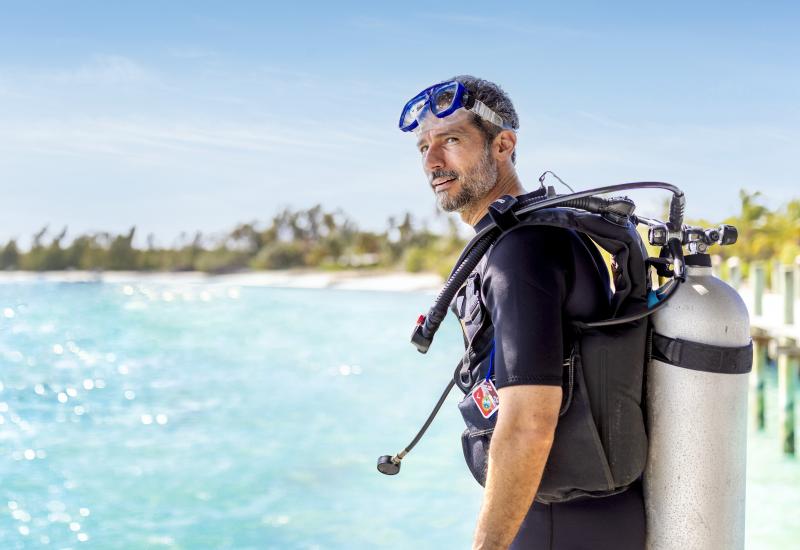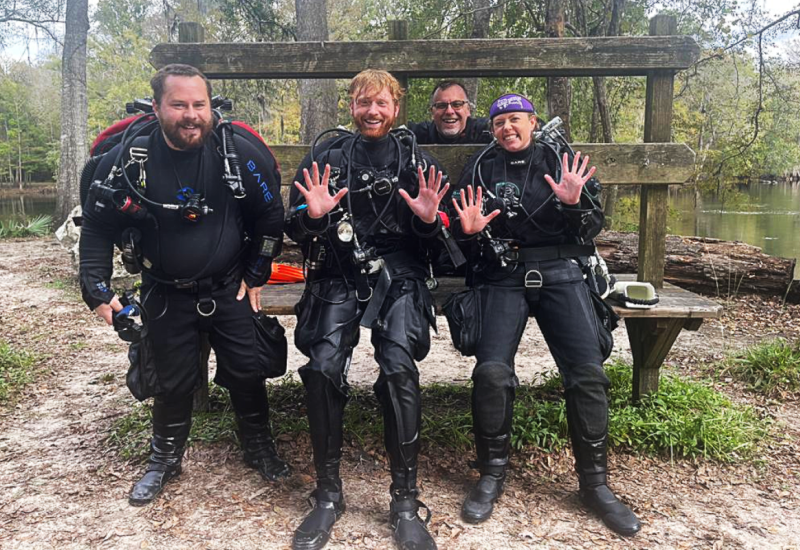SeaView: 5 Rules for Interacting with Wild Dolphins
Blog and Photos by Samantha Whitcraft
Dolphins, like good divers, are at ease in the ocean. But for them, it is not a vacation, a sport or an escape — it is their home, and we are just visitors. When we interact with dolphins in the wild – bottlenose, spotted and spinner are the most common – we are inexplicably drawn in and want to share their seemingly effortless existence. We see them circle and leap, bow-ride and chase, and it all looks so much like “play” to us – it’s almost as if they are demonstrating our joy of the ocean and expressing it in movement. However, most of these behaviors are not play; rather, they are integral to pod structure and even survival.
For divers who have witnessed wild dolphins, there is often no comparison to any other ocean experience. For those who have yet to experience it, they understandably seek such an encounter. Yet, it's important to observe these animals, as with all sea life, in a respectful way. Just as with diving on a coral reef, there is a basic knowledge and skill set needed to enjoy the experience while leaving behind only bubbles. Following a few simple guidelines and understanding some basics of dolphin behavior can help all divers do just that.
Rule No. 1: Know the laws about interacting with wild cetaceans wherever you are visiting. Many countries, including the U.S., have strict restrictions about approach distances and even about being in the water around dolphins and whales. In countries that do allow in-water interactions, research the dive companies or tour operators to assure they are reputable, responsible and knowledgeable about sustainable practices before you choose one.
Rule No. 2: Consider whether full scuba gear or just mask, snorkel and fins are best suited to the interaction, location and habitat. Some animals behave and interact more naturally with snorkelers than divers, so consider brushing up on your duck-diving or taking a good free-diving class to maximize your experience.
Rule No. 3: As with any wild animal, let the dolphins have their space and set their own comfort level. When they are at ease, they are more likely to approach us out of curiosity and stay around longer. As they glide by, the urge to reach out and “pet” them can be overwhelming but doing so often ends the interaction sooner. Additionally, dolphins have delicate skin that can be easily scratched by our fingernails, rings or watches. Therefore, the best posture in the water to keep your new dolphin friends safe and interested is calm and relaxed with hands clasped or arms crossed.
Rule No. 4: Once you’re in the water with a pod of wild dolphins, looking for specific behaviors can be both fascinating and indicative of whether there is any disturbance to the animals. For example, a repeated tail lob (smacking the waters’ surface with tail flukes) can be a sign of agitation, leaps and spins are often attempts to remove an annoying remora, and chuffing, a series of quick exhalations, can be a sign of distress.
On the other hand, repeated contact between dolphins, such as touching pectoral fins, rubbing bellies or synchronous swimming, is thought to be behavior that helps maintain tight family bonds. And mating is often a group activity complete with underwater acrobatics. Overall, as dolphins move through the water they may be traveling (moving in a set direction), milling (either to forage or rest, sleeping with only one half of their brain at a time) or playing – sometimes using a bit of seaweed or marine debris in an apparent game of keep-away. Dolphins will also occasionally spy hop, or raise their bodies vertically to get their head above the water’s surface and look around. These pod dynamics and dolphin behaviors are well documented, so learning a little about them can be both easy and helpful when planning for an encounter. Plus, knowing how to interpret these behaviors can help fine-tune our interactions with wild dolphins, so we minimize affecting any changes in their important daily routines.
Rule No. 5: Most of these natural behaviors can only be experienced with wild dolphins, so seeking a dolphin encounter in the ocean means experiencing the real thing. And seeing these amazing animals behave naturally certainly adds to our enjoyment.
Blog and Photos by Samantha Whitcraft
Dolphins, like good divers, are at ease in the ocean. But for them, it is not a vacation, a sport or an escape — it is their home, and we are just visitors. When we interact with dolphins in the wild – bottlenose, spotted and spinner are the most common – we are inexplicably drawn in and want to share their seemingly effortless existence. We see them circle and leap, bow-ride and chase, and it all looks so much like “play” to us – it’s almost as if they are demonstrating our joy of the ocean and expressing it in movement. However, most of these behaviors are not play; rather, they are integral to pod structure and even survival.

Samantha Whitcraft
For divers who have witnessed wild dolphins, there is often no comparison to any other ocean experience. For those who have yet to experience it, they understandably seek such an encounter. Yet, it's important to observe these animals, as with all sea life, in a respectful way. Just as with diving on a coral reef, there is a basic knowledge and skill set needed to enjoy the experience while leaving behind only bubbles. Following a few simple guidelines and understanding some basics of dolphin behavior can help all divers do just that.

Samantha Whitcraft
Rule No. 1: Know the laws about interacting with wild cetaceans wherever you are visiting. Many countries, including the U.S., have strict restrictions about approach distances and even about being in the water around dolphins and whales. In countries that do allow in-water interactions, research the dive companies or tour operators to assure they are reputable, responsible and knowledgeable about sustainable practices before you choose one.

Samantha Whitcraft
Rule No. 2: Consider whether full scuba gear or just mask, snorkel and fins are best suited to the interaction, location and habitat. Some animals behave and interact more naturally with snorkelers than divers, so consider brushing up on your duck-diving or taking a good free-diving class to maximize your experience.

Samantha Whitcraft
Rule No. 3: As with any wild animal, let the dolphins have their space and set their own comfort level. When they are at ease, they are more likely to approach us out of curiosity and stay around longer. As they glide by, the urge to reach out and “pet” them can be overwhelming but doing so often ends the interaction sooner. Additionally, dolphins have delicate skin that can be easily scratched by our fingernails, rings or watches. Therefore, the best posture in the water to keep your new dolphin friends safe and interested is calm and relaxed with hands clasped or arms crossed.
Rule No. 4: Once you’re in the water with a pod of wild dolphins, looking for specific behaviors can be both fascinating and indicative of whether there is any disturbance to the animals. For example, a repeated tail lob (smacking the waters’ surface with tail flukes) can be a sign of agitation, leaps and spins are often attempts to remove an annoying remora, and chuffing, a series of quick exhalations, can be a sign of distress.
On the other hand, repeated contact between dolphins, such as touching pectoral fins, rubbing bellies or synchronous swimming, is thought to be behavior that helps maintain tight family bonds. And mating is often a group activity complete with underwater acrobatics. Overall, as dolphins move through the water they may be traveling (moving in a set direction), milling (either to forage or rest, sleeping with only one half of their brain at a time) or playing – sometimes using a bit of seaweed or marine debris in an apparent game of keep-away. Dolphins will also occasionally spy hop, or raise their bodies vertically to get their head above the water’s surface and look around. These pod dynamics and dolphin behaviors are well documented, so learning a little about them can be both easy and helpful when planning for an encounter. Plus, knowing how to interpret these behaviors can help fine-tune our interactions with wild dolphins, so we minimize affecting any changes in their important daily routines.
Rule No. 5: Most of these natural behaviors can only be experienced with wild dolphins, so seeking a dolphin encounter in the ocean means experiencing the real thing. And seeing these amazing animals behave naturally certainly adds to our enjoyment.










